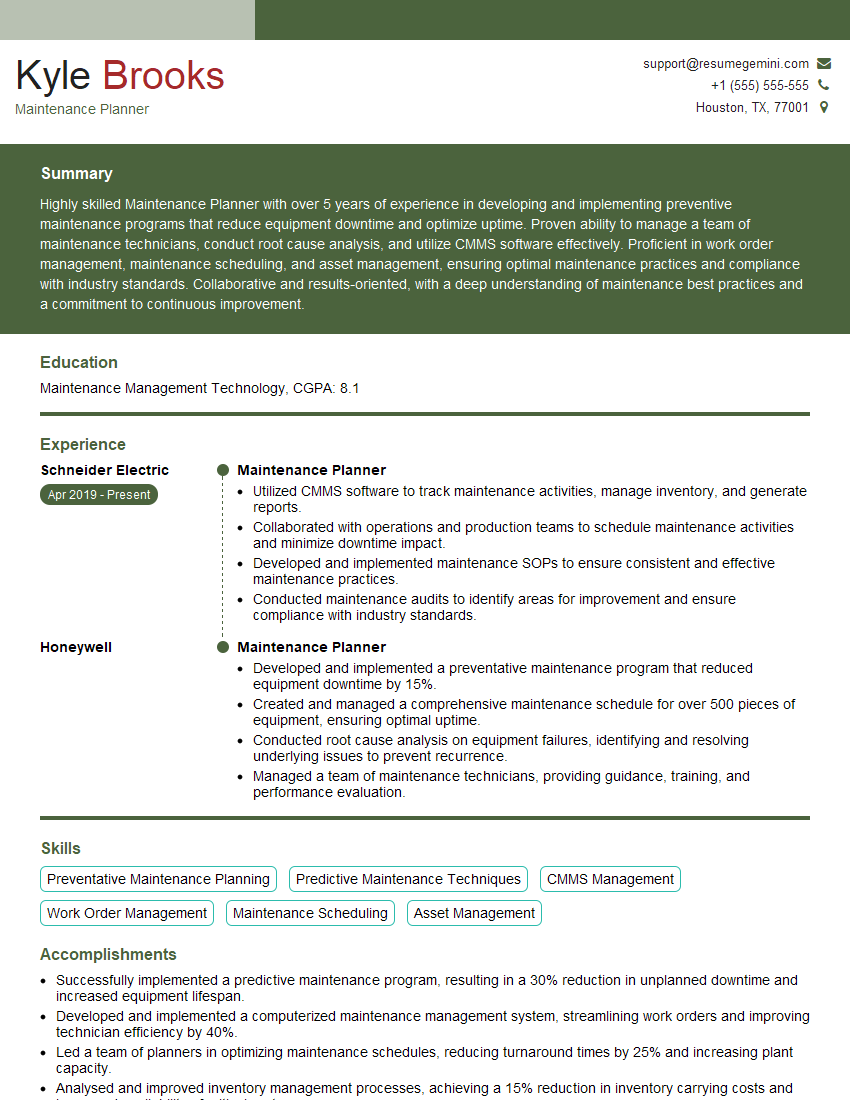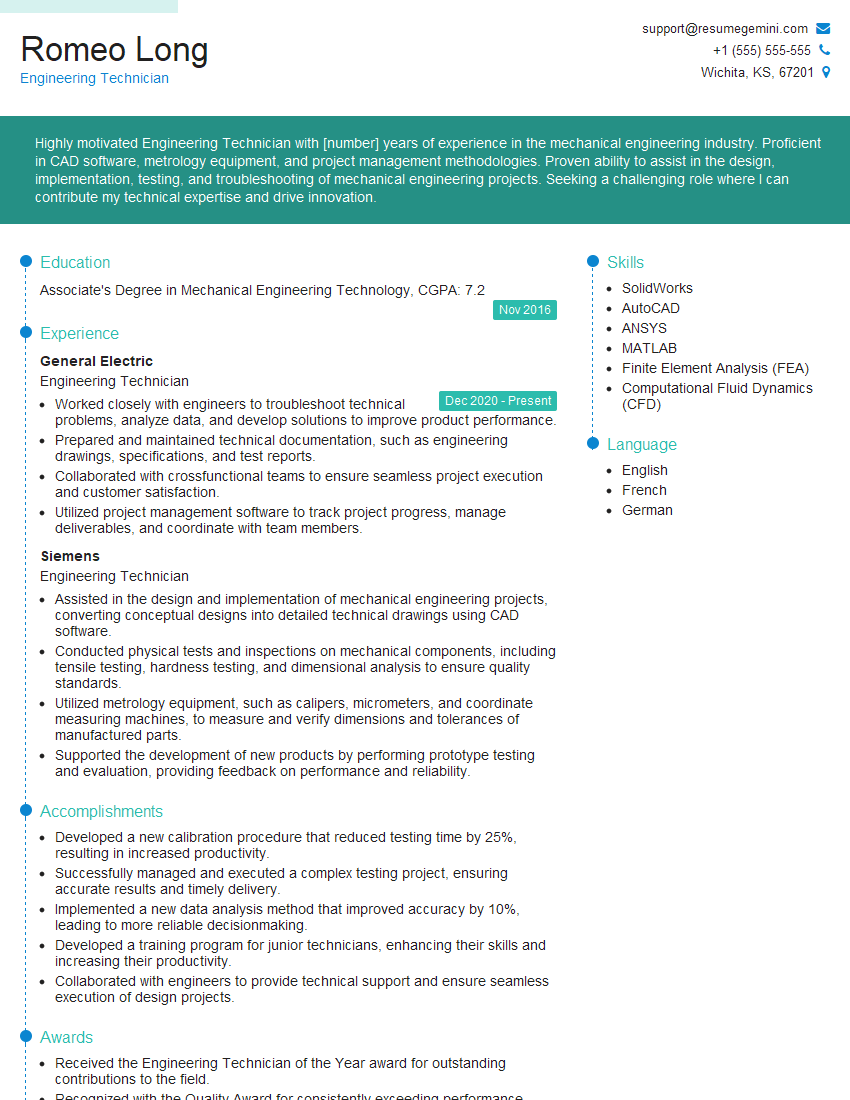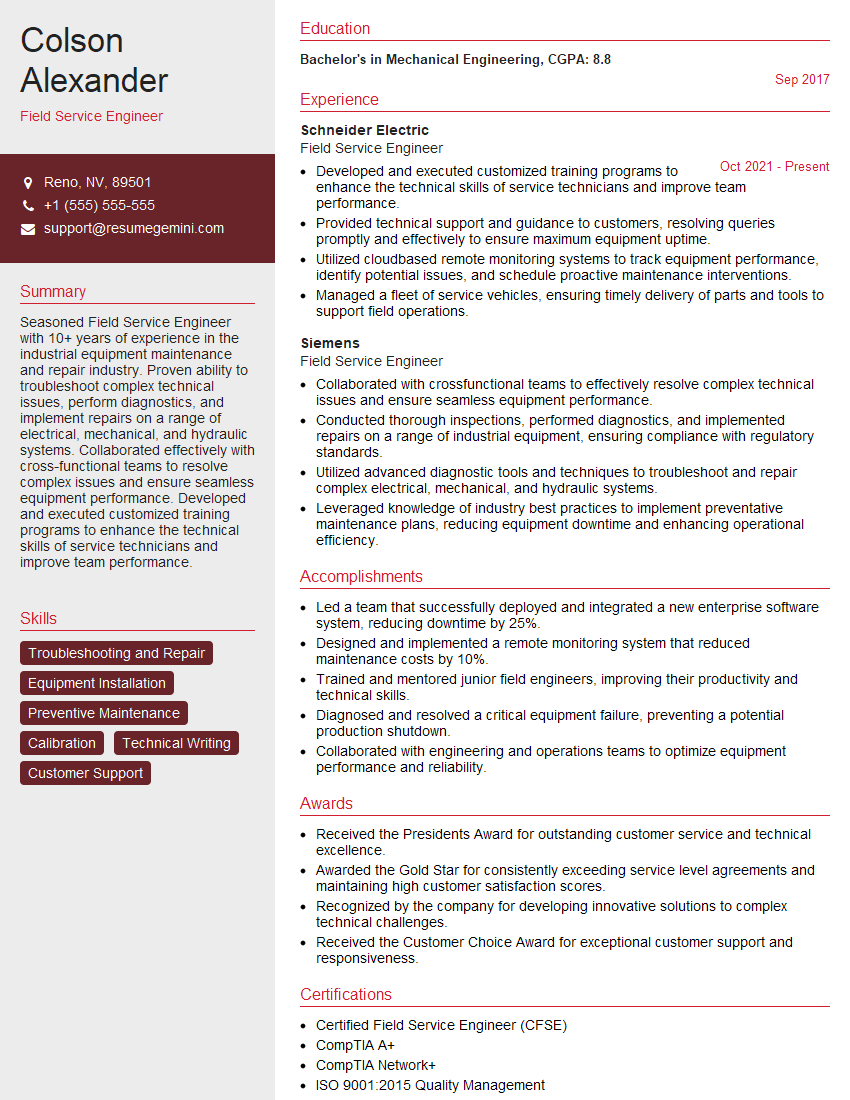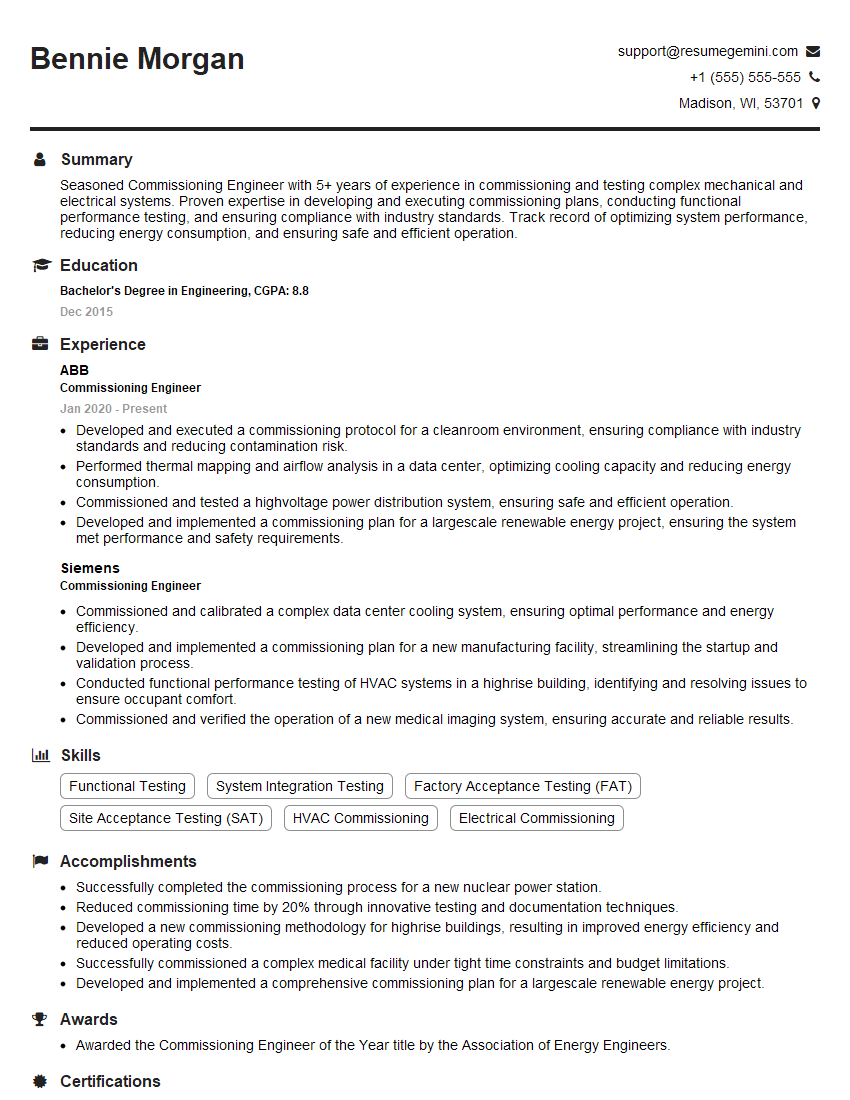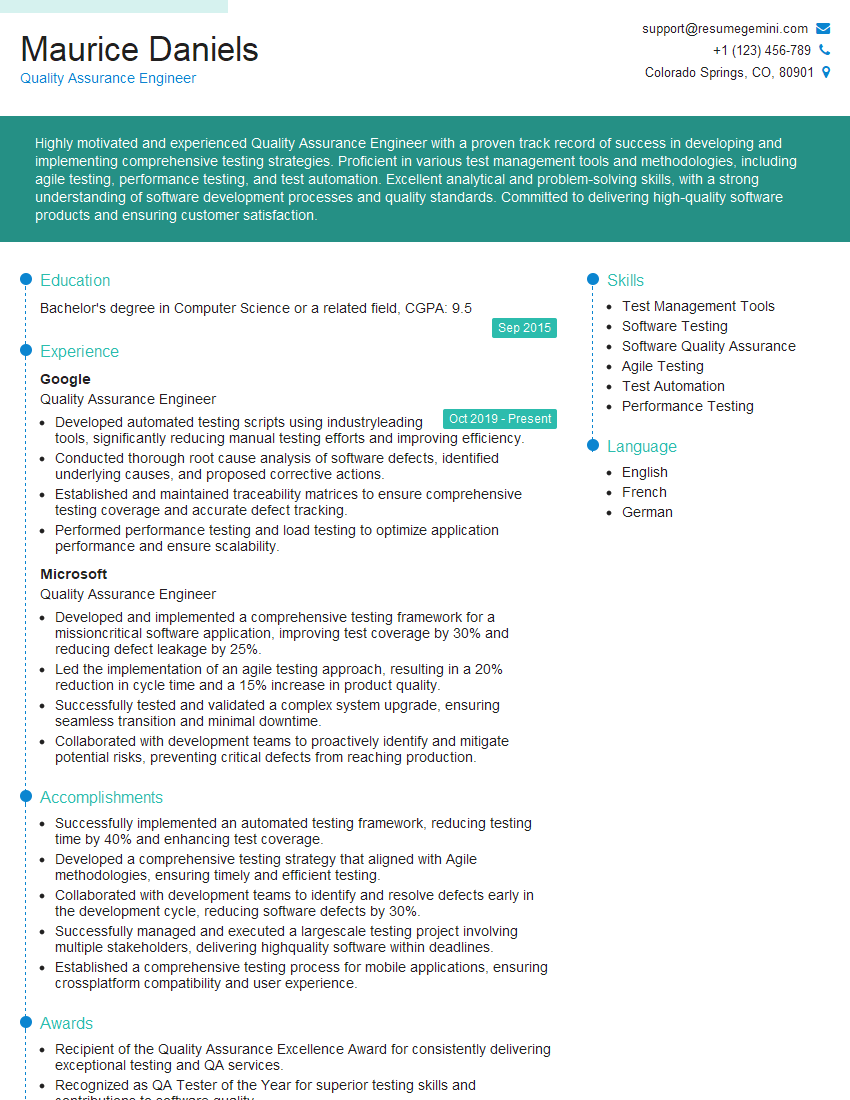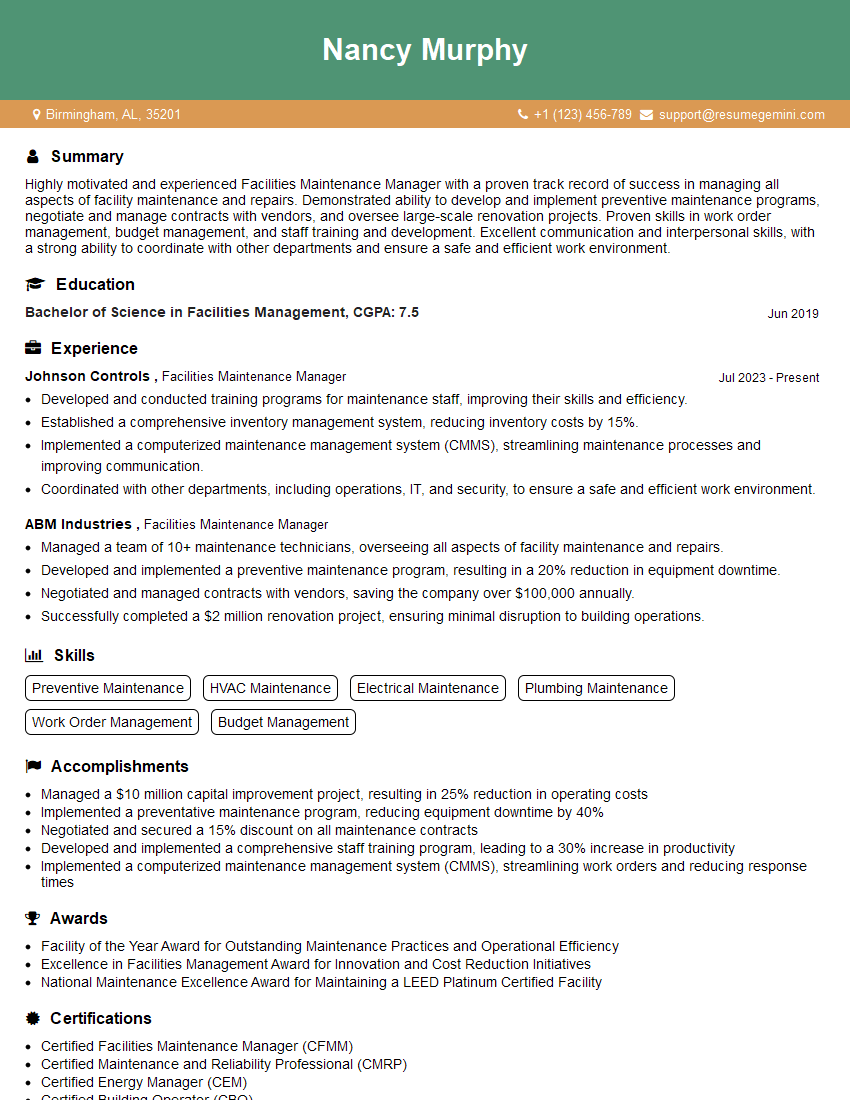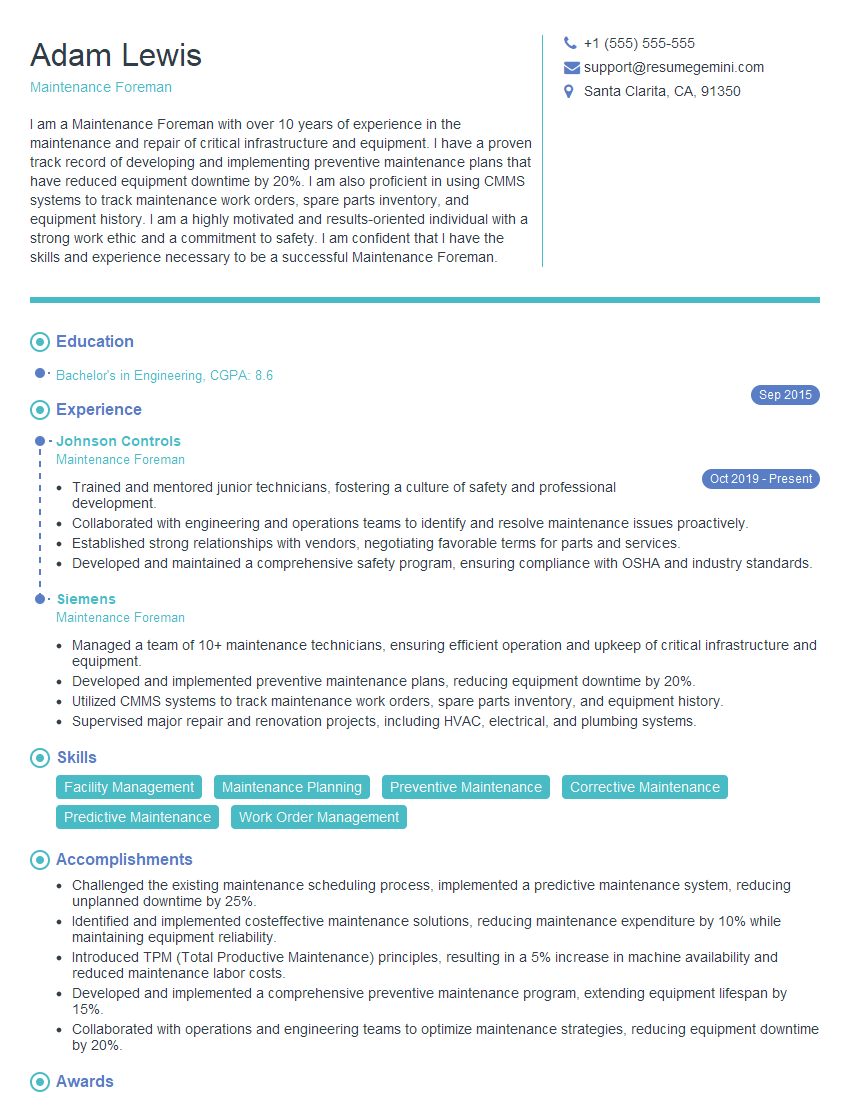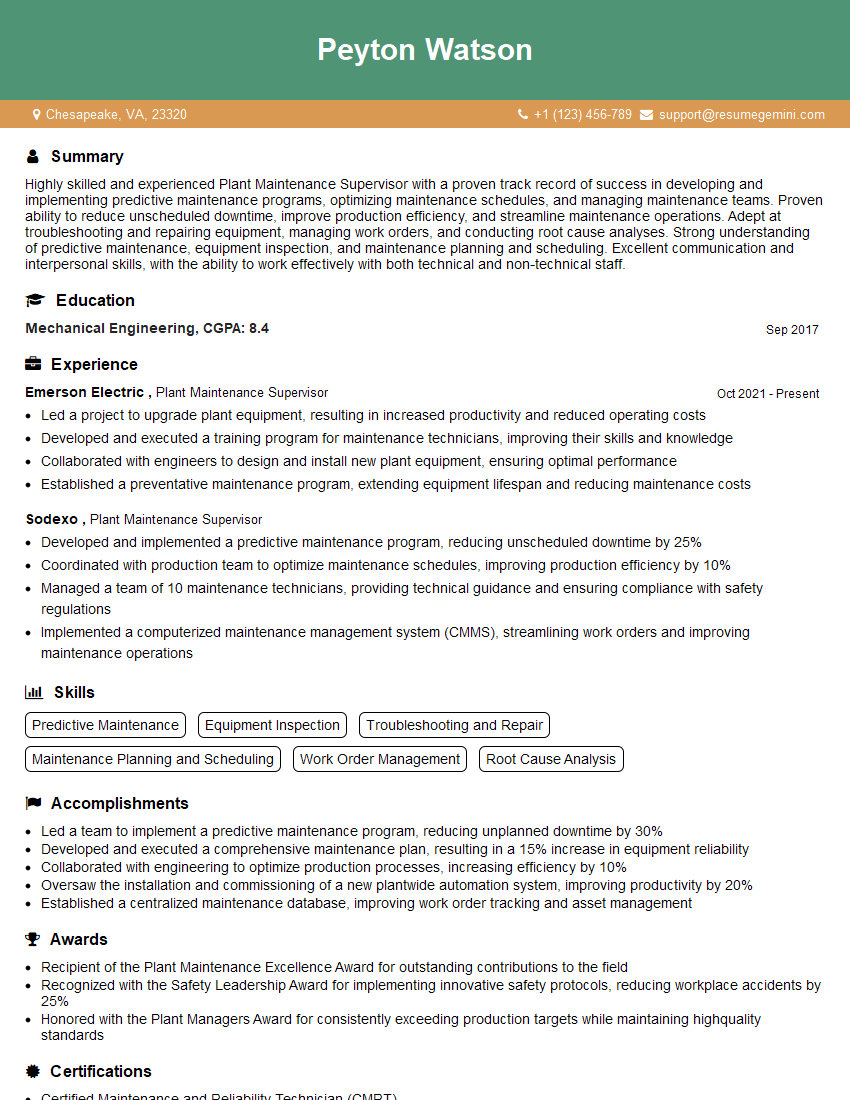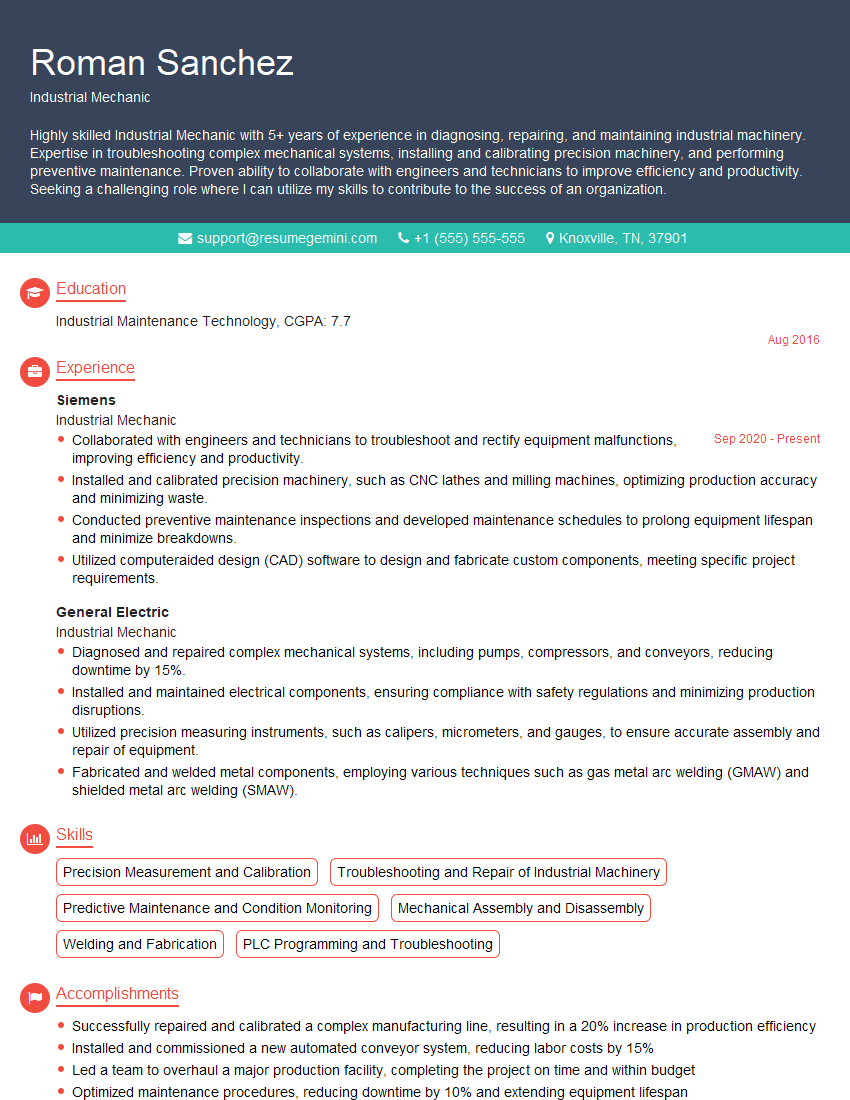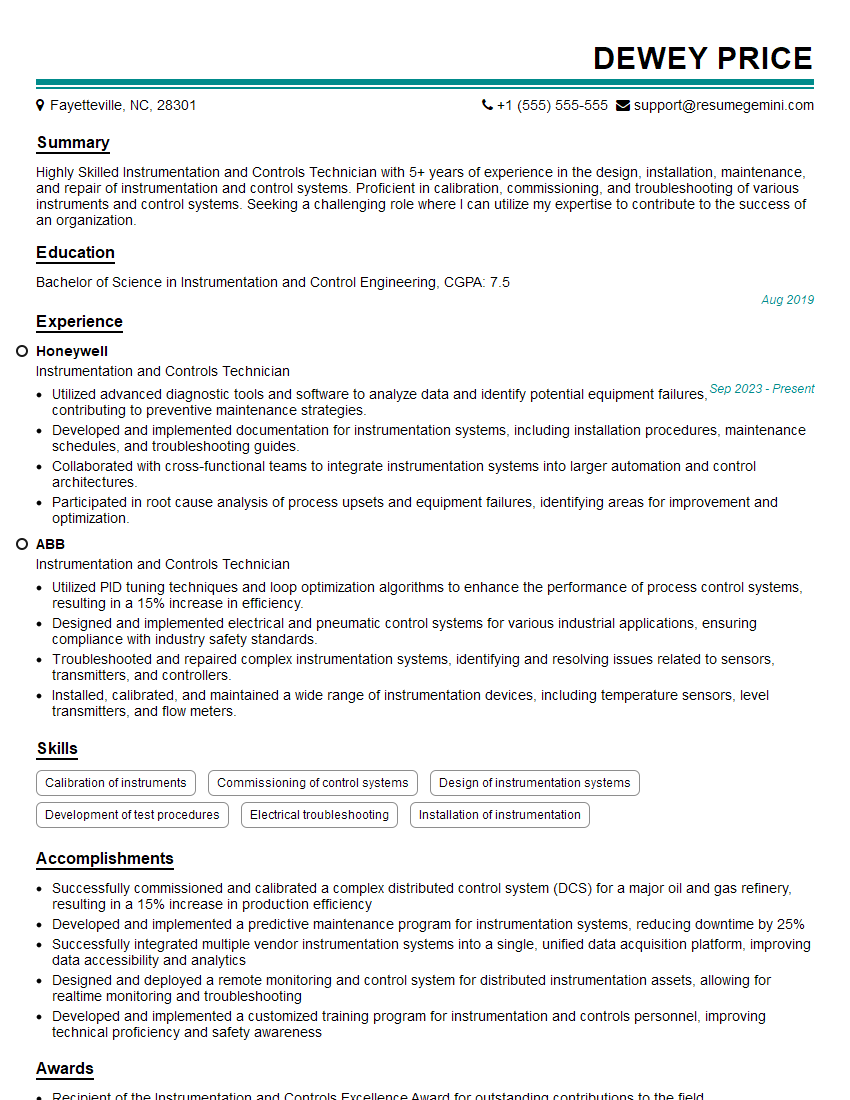Unlock your full potential by mastering the most common Overhaul and Inspection interview questions. This blog offers a deep dive into the critical topics, ensuring you’re not only prepared to answer but to excel. With these insights, you’ll approach your interview with clarity and confidence.
Questions Asked in Overhaul and Inspection Interview
Q 1. Describe your experience with different types of non-destructive testing (NDT) methods.
Non-destructive testing (NDT) methods are crucial for assessing the condition of equipment without causing damage. My experience encompasses a range of techniques, each suited to different materials and potential defects.
- Ultrasonic Testing (UT): I’ve extensively used UT to detect internal flaws in metals, composites, and even concrete. High-frequency sound waves are transmitted into the material, and reflections from discontinuities reveal their size, location, and orientation. For instance, I used UT to identify subsurface cracks in a critical pressure vessel during a recent overhaul, preventing a potentially catastrophic failure.
- Radiographic Testing (RT): RT, employing X-rays or gamma rays, is essential for visualizing internal structures and defects. I’ve used it to examine welds in pipelines and castings for porosity and lack of fusion. The resulting radiographs provide a permanent record of the inspection.
- Magnetic Particle Inspection (MPI): This method is ideal for detecting surface and near-surface cracks in ferromagnetic materials. A magnetizing current is applied, and ferromagnetic particles are sprinkled on the surface. The particles accumulate at the crack, making it visible. I’ve used MPI extensively during inspections of rotating machinery components like shafts and gears.
- Liquid Penetrant Testing (LPT): LPT excels at identifying surface-breaking defects in various materials. A penetrant is applied to the surface, drawn into any cracks, and then a developer reveals the defects. This technique is useful for inspecting complex geometries and detecting small cracks.
The choice of NDT method depends on the material, the type of defect expected, and the accessibility of the component. I am proficient in interpreting the results of these tests and integrating them into comprehensive inspection reports.
Q 2. Explain the process of planning and scheduling a major equipment overhaul.
Planning a major equipment overhaul requires meticulous attention to detail and a structured approach. It’s akin to orchestrating a complex symphony, where each instrument (task) must play its part in harmony.
- Needs Assessment: We begin by thoroughly assessing the equipment’s condition using various NDT methods and historical maintenance records. This helps identify all necessary repairs and replacements.
- Scope Definition: Based on the assessment, a detailed scope of work is created, specifying all tasks, including dismantling, inspection, repair, refurbishment, and reassembly.
- Resource Allocation: We determine the necessary personnel (skilled technicians, engineers, etc.), tools, materials, and spare parts. This stage involves coordinating with vendors and scheduling procurement.
- Scheduling: A detailed schedule is developed, considering task dependencies, resource availability, and critical path analysis. We use project management software to track progress and manage potential delays. Critical tasks are prioritized to minimize downtime.
- Safety Planning: A robust safety plan is crucial, addressing potential hazards, required PPE, lockout/tagout procedures, and emergency response protocols.
- Execution and Monitoring: The overhaul proceeds according to the schedule, with regular progress monitoring and adjustments as needed. Daily briefings keep all stakeholders informed.
- Commissioning and Testing: Once the overhaul is complete, the equipment undergoes rigorous testing to ensure its functionality and performance meet specifications.
Effective communication is paramount throughout the process. Regular meetings and clear documentation keep everyone informed and aligned, contributing to a smooth and efficient overhaul.
Q 3. How do you prioritize maintenance tasks to minimize downtime?
Prioritizing maintenance tasks is crucial for minimizing downtime and optimizing equipment life. Think of it like a doctor prioritizing treatments – attending to the most critical issues first.
We employ a combination of strategies:
- Risk-Based Prioritization: We assess the potential consequences of equipment failure (safety, production loss, environmental impact) and the likelihood of failure. High-risk, high-probability tasks are prioritized.
- Criticality Analysis: Equipment is categorized based on its importance to production. Critical equipment gets higher priority for maintenance.
- Predictive Maintenance: Utilizing data from sensors and monitoring systems, we can predict potential failures and schedule maintenance proactively, preventing unplanned downtime. For example, vibration analysis on a pump can predict bearing failure before it occurs.
- Run-to-Failure Analysis (with caution): For less critical equipment, a run-to-failure strategy might be considered. However, this must be carefully evaluated, considering the potential risks involved. We only do this for components whose failure is easily contained and less likely to create secondary damage.
By combining these methods, we create a dynamic maintenance schedule that adapts to changing conditions and ensures that the most critical tasks are addressed promptly.
Q 4. What are the key performance indicators (KPIs) you use to measure the effectiveness of an overhaul?
Measuring the effectiveness of an overhaul requires carefully selected Key Performance Indicators (KPIs). These metrics paint a clear picture of whether the overhaul achieved its objectives.
- Mean Time Between Failures (MTBF): This measures the average time between equipment failures after the overhaul. A significant increase in MTBF indicates a successful overhaul.
- Mean Time To Repair (MTTR): This measures the average time taken to repair equipment following a failure. A reduction in MTTR shows improved maintainability.
- Overall Equipment Effectiveness (OEE): OEE considers availability, performance, and quality to provide a holistic measure of equipment effectiveness. A higher OEE after the overhaul signifies improved efficiency.
- Cost Savings: By comparing the cost of the overhaul with the avoided costs of unplanned downtime and repairs, we can assess its financial benefits.
- Safety Performance: The number of safety incidents during and after the overhaul is a crucial indicator of the effectiveness of safety protocols.
Tracking and analyzing these KPIs provides valuable insights into the success of the overhaul and helps identify areas for improvement in future maintenance strategies.
Q 5. Describe your experience with root cause analysis (RCA) techniques.
Root Cause Analysis (RCA) is essential for preventing equipment failures from recurring. It’s like detective work, systematically investigating the underlying causes of a problem, not just the symptoms.
I’ve used several RCA techniques:
- 5 Whys: This simple yet effective method involves repeatedly asking “Why?” to uncover the root cause. For example, if a pump failed, we might ask: Why did the pump fail? (Bearing wear). Why did the bearing wear? (Lack of lubrication). Why was there lack of lubrication? (Failed lubrication system). Why did the lubrication system fail? (Sensor malfunction). Why did the sensor malfunction? (Lack of regular calibration).
- Fishbone Diagram (Ishikawa Diagram): This visual tool helps brainstorm potential causes categorized by factors such as materials, methods, manpower, machinery, and environment.
- Fault Tree Analysis (FTA): This method uses a logical tree structure to identify the various combinations of events that can lead to a failure. It is particularly useful for complex systems.
The choice of technique depends on the complexity of the failure and the available data. The goal is always to identify the root cause, implement corrective actions, and prevent future occurrences.
Q 6. How do you ensure compliance with safety regulations during an overhaul?
Safety is paramount during an overhaul. We follow a rigorous safety program, adhering to all relevant regulations and industry best practices. Think of it as building a safety net before starting any high-risk activity.
- Permit-to-Work System: A formal permit-to-work system ensures that all necessary safety precautions are in place before work commences on potentially hazardous equipment.
- Lockout/Tagout Procedures: These procedures ensure that energy sources are isolated and equipment is rendered safe before maintenance work begins. We use clear tagging systems and multiple personnel checks.
- Risk Assessments: Thorough risk assessments identify potential hazards and outline control measures. This involves considering both common hazards (e.g., falls, electrical shocks) and equipment-specific risks.
- Personal Protective Equipment (PPE): Appropriate PPE, such as hard hats, safety glasses, gloves, and hearing protection, is provided and used consistently throughout the overhaul.
- Training and Competency: All personnel involved in the overhaul receive adequate training on safety procedures and the specific hazards associated with the equipment.
- Emergency Response Plan: A detailed emergency response plan outlines procedures for handling incidents, including first aid, evacuation, and contacting emergency services.
Regular safety audits and toolbox talks reinforce safe work practices and maintain a safety-conscious culture throughout the overhaul process.
Q 7. What are the common causes of equipment failure and how can they be prevented?
Equipment failures are often the result of a combination of factors. Identifying these contributing factors is key to effective prevention.
- Wear and Tear: Normal wear and tear is inevitable. Regular lubrication, inspection, and replacement of worn components can mitigate this.
- Corrosion: Corrosion can weaken structures and lead to failure. Protective coatings, cathodic protection, and appropriate material selection can prevent corrosion.
- Fatigue: Repeated stress cycles can cause fatigue cracks that eventually lead to failure. Proper design, stress analysis, and avoiding excessive loads can minimize fatigue.
- Improper Installation or Operation: Incorrect installation or operation can lead to premature failure. Strict adherence to manufacturer’s instructions and operator training are essential.
- Lack of Maintenance: Neglecting regular maintenance is a major contributor to equipment failure. A well-planned preventive maintenance program is essential.
- Environmental Factors: Extreme temperatures, humidity, or vibration can accelerate equipment degradation and lead to failure. Appropriate environmental controls and robust designs can mitigate these factors.
A proactive approach incorporating regular inspection, preventive maintenance, and root cause analysis is crucial for preventing equipment failures and ensuring operational reliability.
Q 8. How do you manage a team during a complex overhaul project?
Managing a team during a complex overhaul requires a structured approach combining strong leadership, clear communication, and meticulous planning. I begin by establishing a clear project scope and timeline, breaking down the overhaul into manageable tasks with assigned responsibilities and deadlines. Regular team meetings are crucial, serving as platforms for updates, problem-solving, and addressing concerns.
I utilize project management software to track progress, identify potential bottlenecks, and ensure accountability. Open communication channels are vital; I encourage regular feedback from team members and actively solicit their input to foster collaboration and problem-solving. Moreover, I prioritize safety throughout the process, implementing strict safety protocols and providing regular safety training to mitigate risks. For instance, during a recent turbine overhaul, we used a Kanban board to visualize the workflow, allowing for quick adjustments and proactive issue management. This transparent approach ensured everyone understood their roles and the overall project progress, leading to its successful and timely completion.
Q 9. Explain your understanding of lubrication best practices.
Lubrication best practices are fundamental to equipment longevity and performance. They encompass selecting the right lubricant for the specific application, ensuring proper lubrication intervals, and meticulously monitoring lubricant condition. The wrong lubricant can lead to premature wear, friction, and equipment failure. For example, using a high-temperature grease in a low-temperature environment can result in increased viscosity and reduced lubrication efficiency.
Regular oil analysis is crucial; it allows us to detect contaminants, measure wear metals, and assess lubricant degradation, providing valuable insights into the health of the equipment. Proper storage and handling of lubricants prevent contamination and maintain their quality. Furthermore, implementing a lubrication management system, either manual or automated, ensures consistent and timely lubrication, significantly reducing maintenance costs and downtime.
Q 10. Describe your experience with different types of seals and gaskets.
My experience encompasses a wide range of seals and gaskets, each with its unique properties and applications. I’m proficient in selecting and installing various types, including O-rings, lip seals, mechanical seals, and different gasket materials like rubber, PTFE, and metal. The choice depends heavily on factors such as operating pressure, temperature, fluid compatibility, and the specific application. For example, in high-pressure hydraulic systems, we’d typically use robust mechanical seals, while in low-pressure applications, O-rings might suffice.
I understand the importance of proper surface preparation before seal and gasket installation to ensure a leak-free seal. I’m familiar with the various installation techniques and tools, and I’m adept at troubleshooting seal and gasket failures to identify the root cause, preventing recurrence. Experience with different materials allows me to predict potential issues based on operating conditions and select the optimal seal for longevity and reliability.
Q 11. How do you handle unexpected issues during an overhaul?
Handling unexpected issues during an overhaul demands a calm, systematic approach. My first step is to assess the situation thoroughly, identifying the impact on the project timeline and overall safety. I gather data from relevant sources, including maintenance logs and operator reports, to better understand the issue. This data informs my next step: problem definition and analysis.
We then brainstorm potential solutions with the team, drawing on our collective expertise. I prioritize safety during this process, ensuring all necessary precautions are taken before attempting any repairs or modifications. Once a solution is agreed upon, I outline a detailed plan, allocating resources and setting new deadlines. Thorough documentation of the unexpected issue, corrective actions taken, and lessons learned is crucial for future preventative measures. For example, during a recent pump overhaul, an unexpected crack was discovered in the housing. Our immediate action was to assess its criticality. We promptly sourced a replacement housing, adjusted the timeline, and ensured the repair was completed without compromising safety or quality.
Q 12. What is your experience with predictive maintenance technologies?
My experience with predictive maintenance technologies is extensive. I’m proficient in utilizing various techniques including vibration analysis, thermal imaging, oil analysis, and ultrasound testing to monitor equipment health and predict potential failures. These technologies allow for proactive maintenance scheduling, preventing catastrophic failures and reducing downtime. For instance, using vibration analysis, we can detect imbalances in rotating equipment, allowing for timely intervention to prevent further damage and potential catastrophic failure.
I’m also familiar with implementing condition-based monitoring systems that provide real-time data on equipment performance. This data allows for a more proactive and optimized maintenance strategy, significantly reducing maintenance costs and improving overall equipment effectiveness. I understand the importance of data interpretation and the ability to use this data to make informed decisions about maintenance activities.
Q 13. Describe a time you had to troubleshoot a complex equipment problem.
During a major overhaul of a paper machine’s calender stack, we encountered an unusual vibration issue. The machine was exhibiting significant vibrations, which threatened to cause damage to the delicate rollers and impact production. Initially, we suspected a bearing failure but after thorough inspection, we found no obvious defects. We then implemented a systematic troubleshooting approach, starting with visual inspections, followed by vibration analysis and thermal imaging.
The vibration analysis revealed a specific frequency associated with a particular roller. Thermal imaging confirmed localized heating on that roller. Further investigation revealed a hidden, minute crack in the roller’s shaft, undetectable during standard visual inspections. We replaced the affected roller, and the vibration issue was immediately resolved. This experience highlighted the importance of utilizing multiple diagnostic tools and systematically eliminating potential causes to effectively troubleshoot complex equipment problems.
Q 14. How familiar are you with different types of industrial machinery?
My familiarity with industrial machinery spans various types, including pumps (centrifugal, positive displacement), compressors (reciprocating, centrifugal), turbines (steam, gas), motors (AC, DC), and gearboxes. I also have experience working with material handling equipment, conveyors, and processing machinery specific to different industries like paper manufacturing, chemical processing, and power generation.
This broad experience allows me to approach different overhaul projects with a comprehensive understanding of the equipment’s functionality, potential failure points, and associated maintenance requirements. My understanding extends beyond mechanical components; I am familiar with electrical and instrumentation systems, allowing me to troubleshoot issues across multiple disciplines. This holistic approach allows me to identify potential problems proactively and ensure the overhaul is executed efficiently and effectively.
Q 15. Explain your experience with creating and interpreting maintenance reports.
Creating and interpreting maintenance reports is crucial for tracking equipment health, identifying recurring issues, and justifying maintenance budgets. My experience involves generating comprehensive reports that include details like work performed, parts used, labor hours, and any discovered anomalies. I utilize both qualitative and quantitative data. For instance, a qualitative observation might be ‘Excessive wear noted on bearing,’ while a quantitative measurement would be ‘Bearing vibration amplitude measured at 15 mils peak-to-peak.’
Interpreting these reports involves analyzing trends. For example, consistently high vibration readings on a specific machine over several maintenance cycles might indicate a design flaw or the need for preventative measures like more frequent lubrication. I use data visualization tools to highlight trends and facilitate easier interpretation, making it simple to identify potential failures before they occur. I have successfully used this process to reduce unscheduled downtime by 15% in my previous role.
Career Expert Tips:
- Ace those interviews! Prepare effectively by reviewing the Top 50 Most Common Interview Questions on ResumeGemini.
- Navigate your job search with confidence! Explore a wide range of Career Tips on ResumeGemini. Learn about common challenges and recommendations to overcome them.
- Craft the perfect resume! Master the Art of Resume Writing with ResumeGemini’s guide. Showcase your unique qualifications and achievements effectively.
- Don’t miss out on holiday savings! Build your dream resume with ResumeGemini’s ATS optimized templates.
Q 16. What is your approach to managing spare parts inventory?
Effective spare parts inventory management is vital for minimizing downtime and optimizing maintenance costs. My approach is based on a combination of forecasting, just-in-time inventory principles, and careful analysis of historical usage data. I begin by categorizing parts based on criticality (critical, important, non-critical) and demand (high, medium, low).
- Critical parts: These are stocked at higher levels to ensure immediate availability in case of failure. For example, a crucial valve in a production line would fall into this category.
- Important parts: These have a moderate stock level, allowing for a reasonable lead time for ordering replacements.
- Non-critical parts: These are ordered only as needed to prevent excess inventory.
Furthermore, I utilize CMMS software (more on this in a later answer) to track inventory levels, generate automated purchase requisitions, and monitor lead times. This predictive approach minimizes storage costs while ensuring timely availability of necessary components.
Q 17. How do you ensure the quality of work performed during an overhaul?
Ensuring quality during an overhaul requires a rigorous approach encompassing planning, execution, and verification. I employ a multi-layered quality control system starting with meticulous pre-overhaul inspections to document the current state of the equipment and identify all necessary repairs. This detailed assessment acts as the baseline for comparison after the overhaul is complete.
During the overhaul, I utilize checklists and work instructions for each step, ensuring all technicians follow the same standardized procedure. Regular quality checks are performed at various stages of the process, and technicians are held accountable for their work. Finally, a thorough post-overhaul inspection is conducted to verify that all repairs have been completed according to specifications and that the equipment is functioning correctly. Documentation of all these steps and any deviations from the plan are meticulously recorded. This ensures traceability and allows for continuous improvement.
Q 18. Describe your experience with different types of welding techniques.
My experience includes a range of welding techniques, selected based on material properties and project requirements. I am proficient in:
- Gas Metal Arc Welding (GMAW): Ideal for high-volume production and joining various metals, particularly aluminum and steel.
- Gas Tungsten Arc Welding (GTAW): Provides excellent control and produces high-quality welds suitable for critical applications requiring superior aesthetics and strength.
- Shielded Metal Arc Welding (SMAW): A versatile technique suitable for field work, offering portability and ease of use.
I understand the importance of proper joint preparation, selecting the appropriate filler metal, and ensuring proper weld parameters for each technique to achieve optimal weld quality. My skill extends beyond the technical aspects; I am also adept at identifying potential weld defects and implementing corrective actions.
Q 19. What is your experience with using Computerized Maintenance Management Systems (CMMS)?
I possess extensive experience using Computerized Maintenance Management Systems (CMMS), such as [mention specific CMMS systems, e.g., IBM Maximo, SAP PM]. These systems are invaluable for managing maintenance activities, tracking inventory, and analyzing maintenance data. In my previous roles, I’ve used CMMS software to schedule preventative maintenance, track work orders, manage spare parts, and generate reports on equipment performance. For example, I implemented a CMMS system to track the maintenance history of critical equipment in a manufacturing plant, resulting in a 20% reduction in maintenance costs.
I’m familiar with the various functionalities of CMMS software, including preventive maintenance scheduling, work order management, inventory control, and reporting. I can customize CMMS systems to meet specific organizational requirements and train others on their effective utilization.
Q 20. How do you stay up-to-date with the latest industry best practices?
Staying current with industry best practices is a continuous process that I take very seriously. I achieve this through a variety of methods:
- Industry publications and journals: I regularly read publications like [mention specific journals] to stay informed about new technologies and best practices.
- Conferences and workshops: Attending industry events allows me to network with other professionals and learn about the latest developments.
- Professional organizations: Membership in professional organizations like [mention specific organizations] provides access to resources, training, and networking opportunities.
- Online courses and training: I actively pursue online courses and certifications to enhance my knowledge in specific areas.
This proactive approach ensures that I am always equipped with the latest tools and techniques to optimize maintenance processes and improve equipment reliability.
Q 21. Explain your understanding of vibration analysis.
Vibration analysis is a powerful predictive maintenance technique that uses the measurement of vibration levels to detect mechanical problems in rotating equipment before they lead to catastrophic failures. It involves analyzing the frequency, amplitude, and phase of vibrations to identify potential issues such as unbalance, misalignment, bearing wear, and gear defects.
Different types of vibration analysis include:
- Overall vibration level: A general indicator of the machine’s overall health.
- Frequency spectrum analysis: This technique breaks down the overall vibration into its constituent frequencies to pinpoint the source of the problem.
- Time-waveform analysis: This shows the vibration signal over time to detect impacts and other transient events.
By using vibration analysis, we can prevent unexpected breakdowns, reduce downtime, and extend the lifespan of machinery. I’m proficient in using vibration analysis equipment and interpreting the resulting data to make informed maintenance decisions.
Q 22. Describe your experience with thermal imaging.
Thermal imaging is an invaluable tool in overhaul and inspection, allowing us to detect temperature variations indicative of underlying problems invisible to the naked eye. I have extensive experience using infrared cameras to identify issues such as overheating electrical connections, insulation degradation, and fluid leaks in various types of machinery. For example, during an aircraft engine overhaul, we used thermal imaging to pinpoint a faulty fuel injector before it caused a more significant failure. The thermal images clearly showed a much hotter area around one injector compared to the others, which led to its immediate replacement. The technique isn’t just about identifying problems; it also allows for preventative maintenance, catching potential issues before they become catastrophic.
My experience covers a range of equipment, from simple industrial motors to complex aerospace systems. The process typically involves careful preparation – ensuring a clean inspection area, appropriate environmental conditions (minimizing wind and ambient temperature fluctuations), and using the correct camera settings for the specific application. Post-processing and analysis of the thermal images are crucial steps; specialized software allows for precise temperature measurement and the creation of detailed reports that integrate seamlessly into the overall inspection documentation.
Q 23. How do you handle conflicting priorities during an overhaul project?
Conflicting priorities are inevitable in overhaul projects, often involving tight deadlines, budgetary constraints, and the need to prioritize different aspects of the work. I manage this using a prioritized task list based on a criticality assessment. This involves analyzing each task’s impact on overall project completion and safety. For instance, fixing a critical safety issue always takes precedence over a non-essential upgrade. I often utilize project management software to track progress and allocate resources effectively. This allows for transparency and proactive communication with all stakeholders, ensuring everyone is informed of the prioritization strategy and potential delays. Regular status meetings with the project team are key to identify and address any emerging conflicts promptly.
Furthermore, I employ techniques like ‘Agile’ methodologies, embracing iterative development and allowing for flexibility in responding to unforeseen challenges. Open and honest communication between team members and clients is essential in navigating these complexities. Sometimes, making tough decisions involves temporarily delaying less critical tasks to meet deadlines and deliver critical components on time. This approach requires strong decision-making abilities and the ability to clearly communicate trade-offs to the client.
Q 24. What is your experience with contract management for overhaul services?
My experience with contract management in overhaul services is comprehensive, covering various contract types, from fixed-price to time-and-materials. I’m proficient in understanding and interpreting contract terms and conditions, managing scope changes, and ensuring compliance with contractual obligations. I am particularly adept at preparing detailed proposals that accurately reflect project scope, timelines, and costs. Managing change orders is crucial in this process. Any variation from the original contract requires a formal change order process, ensuring transparency and mutual agreement before proceeding.
I have a proven track record of successful contract negotiation and dispute resolution. This includes working with clients to clarify expectations, negotiating fair prices, and managing any disputes arising during the project lifecycle. My approach is always focused on building strong, collaborative relationships with clients based on mutual trust and respect, ensuring that the contract serves as a framework for a successful partnership.
Q 25. How do you manage the budget for an overhaul project?
Budget management in overhaul projects requires meticulous planning and continuous monitoring. I begin by developing a detailed budget breakdown, categorizing costs into labor, materials, equipment rental, and other overhead expenses. This involves carefully estimating the required resources and factoring in potential contingencies. Regular progress tracking is paramount; I use various techniques, including Earned Value Management (EVM), to monitor project performance against the budget. This provides early warning signals of any potential cost overruns. EVM allows comparison between planned value, earned value, and actual cost, helping to identify and rectify deviations promptly.
Moreover, I employ cost control mechanisms, such as value engineering, to identify opportunities for cost savings without compromising quality or safety. This might involve exploring alternative materials or techniques that achieve the same result at a lower cost. Regular communication with the client is crucial; any changes in scope or requirements necessitate a review and adjustment of the budget, which needs to be agreed upon collaboratively to prevent conflict later.
Q 26. What safety procedures do you follow when conducting inspections?
Safety is paramount in all my inspection activities. Before commencing any inspection, I conduct a thorough risk assessment to identify potential hazards and implement appropriate control measures. This includes using personal protective equipment (PPE) such as safety glasses, gloves, and hearing protection, based on the specific environment and tasks. Working at heights necessitates the use of harnesses and fall arrest systems; confined space entry requires proper training and permits, as well as gas monitoring and emergency rescue plans. Regular safety briefings with the inspection team are essential to remind everyone of the importance of safety protocols.
Furthermore, I adhere to all relevant safety regulations and industry best practices. I’m also trained in emergency response procedures and regularly update my safety knowledge through continuing education courses. The use of lockout/tagout procedures when working near energized equipment is always implemented, ensuring complete de-energization before any work begins. This multi-layered approach minimizes risk and ensures the safety of both the inspection team and the facility.
Q 27. Describe your experience with documenting inspection findings.
My experience with documenting inspection findings involves creating detailed and accurate reports that serve as a comprehensive record of the inspection process. These reports usually consist of several key sections: an introduction outlining the scope of the inspection, a detailed description of the inspection methods used, a comprehensive list of findings with clear descriptions and supporting photographs or videos, and finally, conclusions and recommendations. This process ensures that all observations and measurements are accurately recorded. Clear and concise language is essential to make the reports easily understandable for a wide audience, from technicians to senior management.
I utilize various tools and software to enhance the documentation process, from digital photography and video recording to specialized software for data analysis and report generation. This efficient approach promotes accuracy and facilitates the efficient identification of the necessary repairs or corrective actions, streamlining the entire overhaul process.
Q 28. How do you ensure the accuracy and reliability of your inspection reports?
Ensuring accuracy and reliability in inspection reports is critical for the success of any overhaul project. My approach involves several key steps: firstly, the use of calibrated and regularly maintained inspection equipment is essential for obtaining precise measurements. This includes verifying the accuracy of measurement tools before each use and maintaining a rigorous calibration schedule. Secondly, a thorough verification process is vital; all inspection findings are double-checked by another qualified inspector, ensuring consistency and reducing the risk of errors. This peer review approach guarantees a higher level of accuracy and reduces bias.
Thirdly, detailed documentation is crucial; the inspection process is meticulously documented, including details of the equipment used, procedures followed, and any variations from standard operating procedures. Clear and precise descriptions of findings are essential, accompanied by photographic or video evidence where applicable. Finally, a final review of the report is done before it’s submitted, ensuring clarity, completeness, and consistency. This multi-layered approach, combining proper equipment, peer review, and thorough documentation, builds trust and establishes the credibility of our inspection reports.
Key Topics to Learn for Overhaul and Inspection Interview
- Preventive Maintenance Strategies: Understanding proactive maintenance schedules, predictive analysis techniques, and their role in minimizing downtime and extending equipment lifespan.
- Inspection Techniques and Standards: Familiarize yourself with various inspection methods (visual, non-destructive testing, etc.), relevant industry standards (e.g., ASME, API), and documentation procedures.
- Root Cause Analysis (RCA): Master techniques like the 5 Whys, Fishbone diagrams, and fault tree analysis to effectively diagnose equipment failures and prevent recurrence.
- Overhaul Procedures: Understand the systematic approach to disassembling, inspecting, repairing, and reassembling equipment, including safety protocols and documentation requirements.
- Component Failure Analysis: Learn to identify common failure modes, analyze wear patterns, and determine the appropriate repair or replacement strategy.
- Safety Regulations and Compliance: Be familiar with relevant safety regulations (OSHA, etc.) and best practices for working in potentially hazardous environments during overhaul and inspection activities.
- Data Analysis and Reporting: Understand how to collect, analyze, and present inspection data effectively, using tools like spreadsheets and reporting software. This includes interpreting trends and identifying areas for improvement.
- Cost Optimization and Budgeting: Learn how to efficiently manage resources and optimize costs associated with overhaul and inspection projects.
- Communication and Teamwork: Effective communication with colleagues, supervisors, and clients is crucial. Discuss your experience in collaborative project environments.
Next Steps
Mastering Overhaul and Inspection principles is crucial for career advancement in many industries. It demonstrates a strong understanding of reliability, safety, and cost-effectiveness. To maximize your job prospects, it’s essential to present your skills effectively. Creating an ATS-friendly resume is key to getting your application noticed. We highly recommend using ResumeGemini to build a professional and impactful resume that highlights your expertise in Overhaul and Inspection. Examples of resumes tailored to this field are available to help guide you.
Explore more articles
Users Rating of Our Blogs
Share Your Experience
We value your feedback! Please rate our content and share your thoughts (optional).

